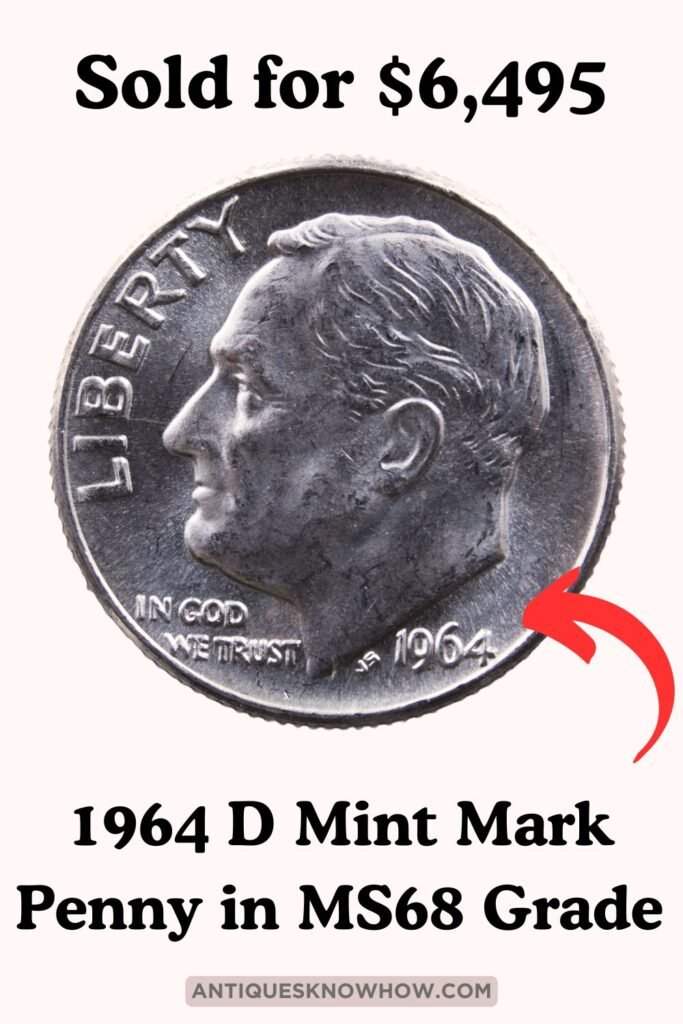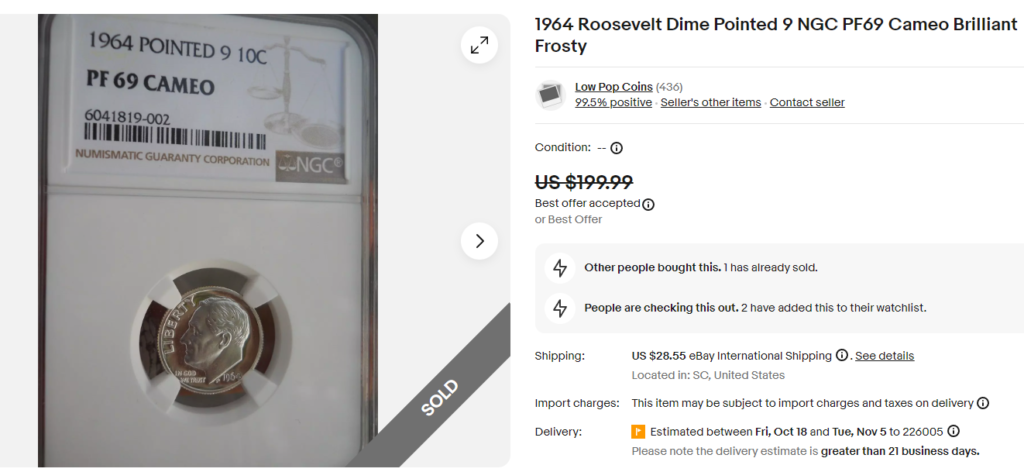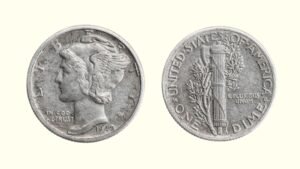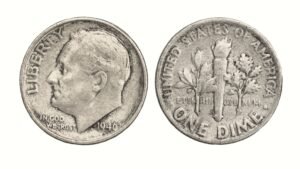Did you know that the 1964 Roosevelt Dime, the last of the 90% silver dimes, can be worth far more than its face value today? That’s right! One rare 1964 Roosevelt Dime coin sold for a whopping $10,200 in a coin auction. If you want to know whether your 1964 silver dime is worth five figures, this article explains all the features you must look for!

Brief History of 1964 Roosevelt Dime
The 1964 Roosevelt Dime is a significant part of the series first introduced in 1946 to honor President Franklin D. Roosevelt, who had passed away in 1945. It was designed by John R. Sinnock, featuring Roosevelt’s bust on the obverse and a torch flanked by olive and oak branches on the reverse.
By 1964, the United States Mint started facing challenges due to rising silver prices. As a result, the 1964 dime was the year of silver dimes before transitioning to a clad composition in 1965. This makes this coin highly collectible despite a total mintage of over 2.2 billion coins.
| 1964 Roosevelt Dime | Key Facts |
| Coin Composition | 91.67% copper, 8.33% nickel |
| Minting Location | Philadelphia, Denver, San Francisco |
| Year of Minting | 1964 |
| Weight | 2.268 g |
| Diameter | 17.91 mm (0.705 in) |
| Thickness | 1.35 mm (0.053 in) |
| Designer | John R Sinnock |
| Face Value | $0.10 (10 cents) |
| Mint Marks | No Mint Marks |
| Total Mintage | 2,290,827,942 coins |
Identifying a 1964 Roosevelt Dime Design & Composition
The first important step to finding a 1964 Roosevelt dime is to identify its design and composition. Here’s a detailed overview:
1964 Roosevelt Dime Obverse:

- A left-facing portrait of Franklin D Roosevelt
- The “IN GOD WE TRUST” motto to the left of Roosevelt
- The word “LIBERTY” along the left edge
- The mint date “1964” below Roosevelt’s neck
- The designer’s initials “JS” at the base of Roosevelt’s neck
1964 Roosevelt Dime Reverse:

- A torch in the center
- An olive branch to the left of the torch
- An oak branch to the right of the torch
- The words “UNITED STATES OF AMERICA” along the top edge
- The denomination “ONE DIME” below the torch
- “E PLURIBUS UNUM” motto to the right of the torch
- The mint mark, if present, to the bottom left of torch
1964 Silver Dime Coin Composition & Dimensions
The 1964 Roosevelt dime is composed of 90% silver and 10% copper, and it weighs approximately 2.5 grams (0.080 ounces). The composition gives the coin a unique gray-silver luster. In contrast, from 1965 onward, dimes were struck using a clad composition consisting of copper-nickel layers over a core of pure copper.
As for dimensions, the 1964 dime has a diameter of 17.91 millimeters (0.705 inches) and a thickness of 1.35 millimeters (0.053 inches). Besides, the coin has a reeded edge with 118 reeds.
Finding a 1964 Roosevelt Dime Value (4 Key Factors)
Generally, a 1964 Roosevelt dime in circulated condition is worth between $2.50 and $3.50 due to its silver content alone. However, rare coins with certain factors, like errors and mint marks, can increase their value to $5,000 or even more! Let’s understand all the factors that influence a 1964 dime coin value.
1. Coin Grading and Condition
Examining a coin’s condition, professionally known as coin grading, is crucial in determining the value of a 1964 Roosevelt Dime. The coin is graded on a scale ranging from Poor (P-1) to Mint State (MS-70), with higher grades meaning better condition and higher value.
For 1964 Roosevelt Dime, MS-67 or higher examples can command prices upwards of up to $1,000 to $2,000 or more.
2. 1964 Roosevelt Dime Full Band Variety
The Full Bands designation (FB) Refers to the band’s clarity and separation on the torch on a 1964 dime reverse. This special feature can significantly impact a dime’s value. For example, a 1964 dime-graded MS68 FB once sold for $1,440 on Heritage Auctions, while a regular 1964 dime is only worth around $400 in the same grade.
However, circulated Full Band 1964 dimes are still worth only a few cents unless they have a rare error.
3. Mint Marks & Mintage

The total mintage for the 1964 silver Roosevelt dime was nearly 2 billion, making it relatively common. However, the value can vary based on the mint mark, and rarity of dimes struck at different locations.
1964 No Mint Mark Dime (Mintage – 929,360,000)
The 1964 Roosevelt Dime with no mint mark was struck at the Philadelphia Mint with a total mintage of over 929 million coins. Due to such high production, these coins are worth around $0.10 in average condition, but high-grade mint examples can reach up to $100 to $1,500!
1964 D Roosevelt Dime (Mintage – 1,357,517,180)
The Denver Mint produced around 1.3 billion dime coins in 1964, identified by the small D mint mark on the reverse. Due to higher mintage, 1964 D dimes sell for around $0.10 in circulated condition, with uncirculated coins in high grades like MS68 fetching up to $4,000 or more!
1964 Roosevelt Dime Proof Coins (Mintage – 3,950,762)
Apart from regular dimes, the Philadelphia Mint also struck around 3.9 million proof dime coins for collectors. Although these coins also do not have a mint mark, you can identify them by their mirror-like finish and sharp details.
The 1964 Proof dimes are further categorized into three designations:
- Regular PR (Proof) Coins: These are standard proof coins with a mirror-like finish on both the field (background) and the design elements. The value of a Regular PR 1964 Roosevelt Dime in excellent condition typically ranges from $3 to $5, with the highest grade, PR70, fetching around $520!
- Cameo (CAM) Proof Coins: 1964 Cameo proofs feature a contrasting finish between the reflective field and the raised design elements. Cameo proofs from 1964 are less common than regular proofs and can fetch $20 and $40 in high PR grades.

- Deep Cameo (DCAM) or Ultra Cameo Proof coins: Deep Cameo proofs exhibit the strongest contrast between the mirrored fields and the frosted design elements. Deep Cameo 1964 Silver Roosevelt Dimes are the rarest of all, with PR69 examples reaching $150 and PR70 examples reaching $4,500 or more!
1964 Silver Roosevelt Dime SMS (Special Mint Set)
The existence of 1964-dated SMS coins has been a debatable topic among numismatists. While the U.S. Mint didn’t produce any SMS sets in 1964, some collectors alleged that it did, in fact, release a small number of SMS-quality 1964 Roosevelt Dimes.
Due to this controversy, a 1964 Silver Roosevelt Dime SMS coin can easily fetch $3,500 to 10,000, like this SP66-grade example that sold for an auction record price of $10,200 on Heritage Auctions.
To spot a rare 1964 SMS dime, look for a stain-like finish with sharp strikes and well-defined details. Besides, these coins can be slightly different in color than regular proofs and circulation dimes.
4. Valuable 1964 Roosevelt Dime Errors List
Minting errors can significantly enhance the value of a 1964 Roosevelt dime. Here are some notable errors to look for:
Off-Center Strike
One of the most notable errors is the off-center strike, which happens when the silver coin planchet is misaligned in the collar, resulting in a partial design. A 1964 Roosevelt Dime struck 35% off-center and sold for $204 at a Heritage Auction. The value generally depends on how dramatic the error is and whether the mint date is visible or not!
Wrong Planchet Error (Struck on a Cent Alloy Planchet)
This is another rare error struck during the final year of silver dimes. This rare coin resulted from a strip of copper for cent planchets mistakenly running through the planchet-cutting machine and getting struck as a dime. You can spot this with its copperish color and weight, which is different from a regular dime.
This error coin can be extremely valuable in good condition. For example, an MS64-grade 1964 D Roosevelt Dime struck on a cent planchet sold for a staggering price of $3,450 on Heritage Auctions!
Clipped Planchet
A clipped planchet error occurs when part of the metal blank is missing due to an issue during production. While most of these clips are curved in shape, in rare conditions, there can be an irregular or “ragged clip.”
Depending on the condition, the value of such coins can range from $50 to $200 or more. I found an MS64 Ragged Clip 1964 D Dime that sold for over $170, while an MS72 Dime with a curved clip sold for around $114 in a coin auction!
Reverse Die Cap
A Reverse Die Cap error occurs when a coin gets stuck to the reverse die during the minting process and is struck multiple times, causing its edges to raise like a bottle cap. An MS66 dime with a reverse die cap error and full band designation was sold for $288 at Heritage Auctions. More intense capped errors can be more valuable!
Is Your 1964 Roosevelt Dime Silver? 4 Steps to Find Out
If you’re not sure whether your 1964 dime is silver, follow these simple steps:
- Check the Date: Ensure your dime is dated 1964. All Roosevelt Dimes minted in 1964 and earlier were made of 90% silver.
- Weigh the Coin: A genuine silver 1964 Roosevelt Dime should weigh approximately 2.5 grams. Copper-nickel-clad dimes (introduced in 1965) weigh about 2.27 grams.
- Examine the Edge: A silver dime will have a solid silver color on its edge, with no copper-colored layer visible.
- Do the Magnet Test: Place a strong magnet near the coin. If the coin is not attracted to the magnet, it’s likely silver. But remember, this test alone isn’t definitive, as copper-nickel-clad coins aren’t magnetic either.)
Note: This article is intended for informational, educational, and entertainment purposes only. Some images are illustrative and may not represent actual brands, products, or related entities. All trademarks, product names, brand logos, packaging, and other intellectual property referenced remain the exclusive property of their respective owners. Any brand mentions or references are provided solely for descriptive and educational context and do not imply any formal or commercial association.





